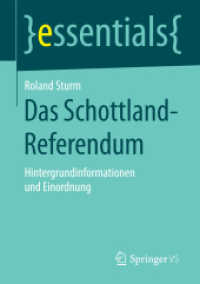- ホーム
- > 洋書
- > 英文書
- > Science / Mathematics
Full Description
Source Separation in Physical-Chemical Sensing Master advanced signal processing for enhanced physical and chemical sensors with this essential guide
In many domains (medicine, satellite imaging and remote sensing, food industry, materials science), data is obtained from large sets of physical/chemical sensors or sensor arrays. Such sophisticated measurement techniques require advanced and smart processing for extracting useful information from raw sensing data. Usually, sensors are not very selective and record a mixture of the useful latent variables. An innovative technique called Blind Source Separation (BSS) can isolate and retrieve the individual latent variables from a mixed-source data array, allowing for refined analysis that fully exploits these cutting-edged imaging and signal-sensing technologies.
Source Separation in Physical-Chemical Sensing, supplies a thorough introduction to the principles of BSS, main methods and algorithms and its potential applications in various domains where data are obtained through physical or chemical sensors. Designed to bridge the gap between chemical/physical analysis and signal processing, it promises to be invaluable in many fields. Its alertness to the latest technologies and the full range of potential BSS applications make it an indispensable introduction to this cutting-edge method.
Source Separation in Physical-Chemical Sensing readers will also find:
BSS examples on chemical and physical sensors and devices to enhance processing and analysis.
Detailed treatment of source separation in potentiometric sensors, ion-sensitive sensors, hyperspectral imaging, Raman and fluorescence spectroscopy, chromatography, and others.
Thorough discussion of Bayesian source separation, nonnegative matrix factorization, tensorial methods, geometrical methods, constrained optimization, and more.
Source Separation in Physical-Chemical Sensing is a must-have for researchers and engineers working in signal processing and statistical analysis, as well as for chemists, physicists or engineers looking to apply source separation in various application domains.
Contents
About the Editors xiii
List of Contributors xv
Foreword xvii
Preface xxi
Notation xxiii
1 Overview of Source Separation 1
Christian Jutten, Leonardo Tomazeli Duarte, and Saïd Moussaoui
1.1 Introduction 1
1.2 The Problem of Source Separation 3
1.3 Statistical Methods for Source Separation 15
1.4 Source Separation Problems in Physical--Chemical Sensing 24
1.5 Source Separation Methods for Chemical--Physical Sensing 30
1.6 Organization of the Book 35
2 Optimization 43
Emilie Chouzenoux and Jean-Christophe Pesquet
2.1 Introduction to Optimization Problems 43
2.2 Majorization--Minimization Approaches 50
2.3 Primal-Dual Methods 72
2.4 Application to NMR Signal Restoration 83
2.5 Conclusion 91
3 Non-negative Matrix Factorization 103
David Brie, Nicolas Gillis, and Saïd Moussaoui
3.1 Introduction 103
3.2 Geometrical Interpretation of NMF and the Non-negative Rank 105
3.3 Uniqueness and Admissible Solutions of NMF 112
3.4 Non-negative Matrix Factorization Algorithms 118
3.5 Applications of NMF in Chemical Sensing. Two Examples of Reducing Admissible Solutions 129
3.6 Conclusions 141
4 Bayesian Source Separation 151
Saïd Moussaoui, Leonardo Tomazeli Duarte, Nicolas Dobigeon, and Christian Jutten
4.1 Introduction 151
4.2 Overview of Bayesian Source Separation 152
4.3 Statistical Models for the Separation in the Linear Mixing 159
4.4 Statistical Models and Separation Algorithms for Nonlinear Mixtures 173
4.5 Some Practical Issues on Algorithm Implementation 177
4.6 Applications to Case Studies in Chemical Sensing 182
4.7 Conclusion 191
5 Geometrical Methods -- Illustration with Hyperspectral Unmixing 201
José M. Bioucas-Dias and Wing-Kin Ma
5.1 Introduction 201
5.2 Hyperspectral Sensing 202
5.3 Hyperspectral Mixing Models 206
5.4 Linear HU Problem Formulation 208
5.5 Dictionary-Based Semiblind HU 222
5.6 Minimum Volume Simplex Estimation 227
5.7 Applications 239
5.8 Conclusions 244
6 Tensor Decompositions: Principles and Application to Food Sciences 255
Jérémy Cohen, Rasmus Bro, and Pierre Comon
6.1 Introduction 255
6.2 Tensor Decompositions 261
6.3 Constraints in Decompositions 273
6.4 Coupled Decompositions 279
6.5 Algorithms 286
6.6 Applications 297
References 307
Index 325







